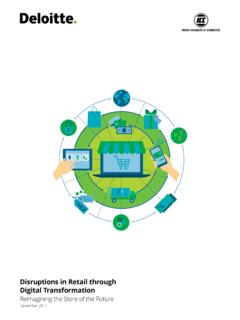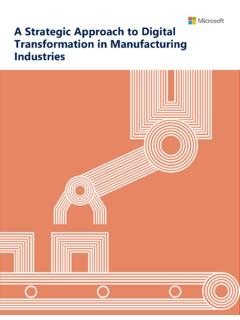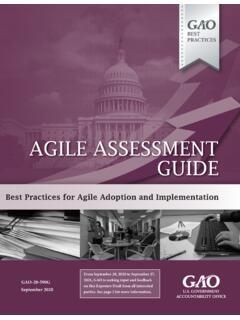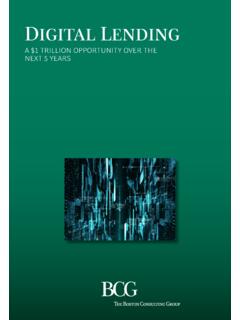Transcription of Changing role of people management in the digital era
1 The Changing role of people management in the digital age 1 The Changing role of people management in the digital ageThe Changing role of people management in the digital age 2 digital has been a driving force of change across industries; and the transformation is accelerating it took five years for Apple to transform the music industry while Uber and Airbnb profoundly reshaped the transportation and hospitality sectors in less than two years. One can measure the pace of digital disruption in months while it takes years for an organization and its people to fully embrace such fundamental changes in the way they operate. Change management is by far the most enduring bottleneck to digital transformation . While technology adoption continues to be top of mind in all digital things, we advocate in this point of view that fundamental changes in leadership and talent attributes are far more critical to successfully embark in the digital general overview of the digital transformation and implications on HRDigital transformation is no longer a niche interest as it jumps out of the tech department and into the boardroom of leaders across industries, sectors and geographies.
2 The current digital age is but a stepping-stone in the evolution of a world enabled by the exponential use of technology in the workplace. The digital age is moving at such a fast pace that it is fundamentally transforming the way organizations operate, be it in the private or the public sector, and is requiring them to develop new ways of thinking about service delivery that influence the way operating models are designed. Hence the profound effects on the functions of the Human Resources (HR) departments in these organizations and their role in identifying new approaches to managing people . Organizational implications of the digital economyPrior to diving into the implications on HR functions, it is important to identify selected organizational implications of the digital economy: Increasingly, responsibility is sitting closer to wheredecisions are most effective: Organizations are becoming flatter and decision-making leaner.
3 Leaders have always focused on outcomes. Withthe digital transformation , there are technological enablers that make it possible to measure and test the soundness of decisions quickly and easily. Mobility and flexibility are crucial for employees toremain relevant in the digital economy. Accordingly, competencies are transferable and internal and global movements are more appealing to both employers and being said, the HR dilemma no longer lies solely between cost savings and value added. Instead, HR s concerns will soon be revolving around the Changing nature of the organization and employees becoming increasingly digital and influenced by the following disruptive themes: digital mega trends, including but not limited to,cyber, data, cloud, social and mobile. A multi-generational workforce includingMillennials or first-generation digital citizens. Merging work and life with hyper- connected employees.
4 Emergence of a new set of digitallyskilled employees. Business models under stress from digital disruption. The employee being perceived as the first consumerof the employer s brand. HR needs to be more pre-emptive with regard to digital transformation as it plays an important role in shaping the organization s digital identity. It is a challenge and a real complexity to plan future capabilities of a workforce in the digital economy; as is the ability to integrate the right people into a dynamic organizational context and help existing employees and leaders gain new digital competencies to be able to drive Changing role of people management in the digital age 3If the workforce is to change, the workplace needs to change tooThe three main areas that HR needs to acquire or strengthen its role in and that are directly related to the success of the digital transformation journey, are outlined below.
5 Re-structuring the organization to enablethe digital transformation : Prior to initiating the transformation , the leadership team in any organization must align its thought as to what digital means to the organization and how it will fit into the overall business model. This alignment will shape the digital operating model of the organization that is composed of aggregated future state digital capabilities ( , processes, people and technologies). It is HR s role to map the future required digital capabilities and where they should be executed in the organization. digital capabilities revolve around the following main areas in the operating model: Strategy: How will digital drive value for the organization? What role does the organization want to play in the digital space? How does it want to win in the digital era? Planning and operations: How will digital plan, operate, monitor and track value captured?
6 Product or service development: what are the technical capabilities required for product or service development? Innovation: What are the capabilities required to drive the innovation needed to meet the strategic objectives of the digital operating model under construction? User experience: What are the capabilities needed to understand the needs of customers? How will those needs be catered to ( , channels, marketing mix)? After defining the capabilities required, HR needs to support its organization in linking those capabilities to specific roles and responsibilities. HR would need to follow a structured (yet agile) process covering mainly the following activities: Evaluate the amount of work associated witheach capability. Determine roles needed based on the evaluatedamount of work. Define roles and responsibilities allocated tounique positions. Determine proper span of control that allows foreffective, lean and scalable the phased approach of mapping capabilities to roles, HR needs to design an organizational structure that aligns with the said organization s strategic objectives.
7 Based on the designed future structure and positions, HR is then required to assess the gap in talent between the current and future roles and identify creative ways to bridge any gap. Embracing the digital talent lifecycle: The talentplan should be directly linked to the digital strategy of the organization supporting HR in filling the gap between current and future digital competencies. HR plays an important role in managing the talent lifecycle in a digital environment, from acquisition to development and retention. Plan and acquire: Attracting the best-fit talent is all about creating a compelling employee value proposition. digital talent is scarce and it is challenging for organizations to find the required competencies in the market. They must promote themselves to potential staff. The recruitment process should portray the organization as a digital brand utilizing innovative s role is crucial in creating recruitment channels and messages to market the modern organization, especially in a competitive environment where supply is low and yet demand is growing exponentially.
8 Additionally, HR should focus on attracting individuals who are digitally savvy and socially aware since they are key for organizations going forward. It is much more likely that employees who are experienced with digital tools such as social media, mobile banking and online shopping will understand the impact they can have on the organization during the digital transformation . Lead and develop: Organizations should enable a learning environment and invest in existing capabilities within the organization. They should utilize their existing pool of talent by providing their employees with the tailored learning and development framework to transition them to digital . It is the responsibility of HR functions to develop and offer education programs through a variety of channels and to allow employees to take ownership of their development plans, not only to build technical skills but also to adapt and The Changing role of people management in the digital age 4develop new ways of working in alignment with the organization s digital strategy.
9 HR also plays a role in further up-skilling employees on understanding the cultural shift that is happening. A digital culture is one that embraces information and insight, and recognizes the value of autonomy, entrepreneurship and creativity. It creates an environment of openness, opportunity and trust, and allows the organization to be flexible, adaptive and responsive to change. It enables ways of operating that can deliver exponential and disruptive changes in performance. Engage and retain: HR supports organizations in retention by investing in employee engagement initiatives and making the workplace appealing to the right talent at the right time. It is important that organizations adopt innovative and collaborative techniques and encourage the use of digital platforms, giving talent the rules to live by and the freedom to live with them allowing employees the flexibility to work from wherever is most convenient to them.
10 However this could eventually prove burdensome to employees as they are constantly connected. HR s role would then be to monitor the overall well-being of the workforce. Empowering digital leadership: digital leadersplay a critical role in paving the way for the digital transformation and should heavily engage and communicate with key stakeholders (whether internal or external to the organization) in deciding, designing and delivering the digital organization. digital leaders should set clear costs, risks, mitigations and benefits of the digital transformation and decide on types of change management interventions that are needed to guide the organization through the , leaders should be equipped with the adequate capabilities to be able to lead and manage the journey. HR plays an important role in enabling digital leaders in the organization and equipping them with the required essential skills and furthering their leadership of key essential leadership skills that have been deduced from organizations that have undergone successful digital transformations are: A comprehensive understanding of the digital market.















